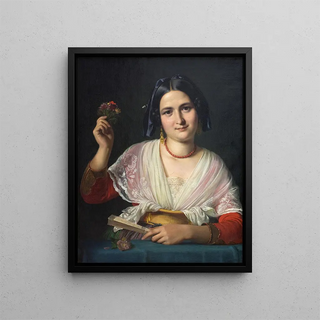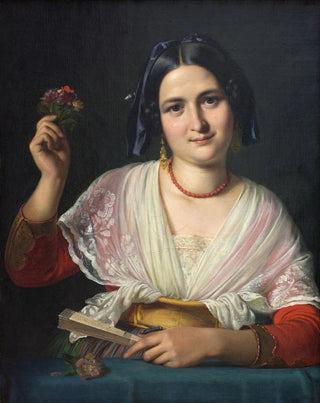Art print | A Roman woman in fantasy costume - Wilhelm Marstrand


View from behind

Frame (optional)
In the world of art, some works transcend eras and evoke deep emotions. The art print Une femme romaine en costume de fantaisie - Wilhelm Marstrand is a perfect example. This painting, which immerses us in the refined universe of ancient Rome, invites us to explore an aesthetic that is both historical and imaginative. Danish artist Wilhelm Marstrand, known for his portrait talents and his ability to capture beauty and grace, presents us with a woman dressed in a Roman costume, both rooted in the past and reinvented through imagination. This piece, at once delicate and bold, transports us to a world where dreams and reality meet, offering a unique vision of femininity through the lens of history.
Style and uniqueness of the work
The uniqueness of this work lies in its ability to blend realism and romanticism. Marstrand, with his keen sense of color and light, manages to create an almost tangible atmosphere. The drapery of the woman's dress, carefully rendered, evokes the richness of textiles from the era, while the choice of colors, both vivid and subtle, gives the composition emotional depth. The pose of the woman, both graceful and confident, suggests a strong personality—a woman who, although frozen in time, seems ready to rise beyond the conventions of her era. This painting does not merely depict a historical figure; it tells a story, that of a Roman woman who embodies both tradition and innovation, the past and the present.
The artist and his influence
Wilhelm Marstrand, born in 1810, is an emblematic figure of Danish romanticism. His artistic journey is marked by an incessant quest for beauty and harmony, which he expresses through his portraits and genre scenes. Influenced by the great masters of European painting, Marstrand develops a style that is uniquely his own, skillfully blending classical and contemporary influences. His work reflects an era where art was meant to celebrate the individual and their emotions. Through his creations, he invites the

Matte finish

View from behind

Frame (optional)
In the world of art, some works transcend eras and evoke deep emotions. The art print Une femme romaine en costume de fantaisie - Wilhelm Marstrand is a perfect example. This painting, which immerses us in the refined universe of ancient Rome, invites us to explore an aesthetic that is both historical and imaginative. Danish artist Wilhelm Marstrand, known for his portrait talents and his ability to capture beauty and grace, presents us with a woman dressed in a Roman costume, both rooted in the past and reinvented through imagination. This piece, at once delicate and bold, transports us to a world where dreams and reality meet, offering a unique vision of femininity through the lens of history.
Style and uniqueness of the work
The uniqueness of this work lies in its ability to blend realism and romanticism. Marstrand, with his keen sense of color and light, manages to create an almost tangible atmosphere. The drapery of the woman's dress, carefully rendered, evokes the richness of textiles from the era, while the choice of colors, both vivid and subtle, gives the composition emotional depth. The pose of the woman, both graceful and confident, suggests a strong personality—a woman who, although frozen in time, seems ready to rise beyond the conventions of her era. This painting does not merely depict a historical figure; it tells a story, that of a Roman woman who embodies both tradition and innovation, the past and the present.
The artist and his influence
Wilhelm Marstrand, born in 1810, is an emblematic figure of Danish romanticism. His artistic journey is marked by an incessant quest for beauty and harmony, which he expresses through his portraits and genre scenes. Influenced by the great masters of European painting, Marstrand develops a style that is uniquely his own, skillfully blending classical and contemporary influences. His work reflects an era where art was meant to celebrate the individual and their emotions. Through his creations, he invites the






